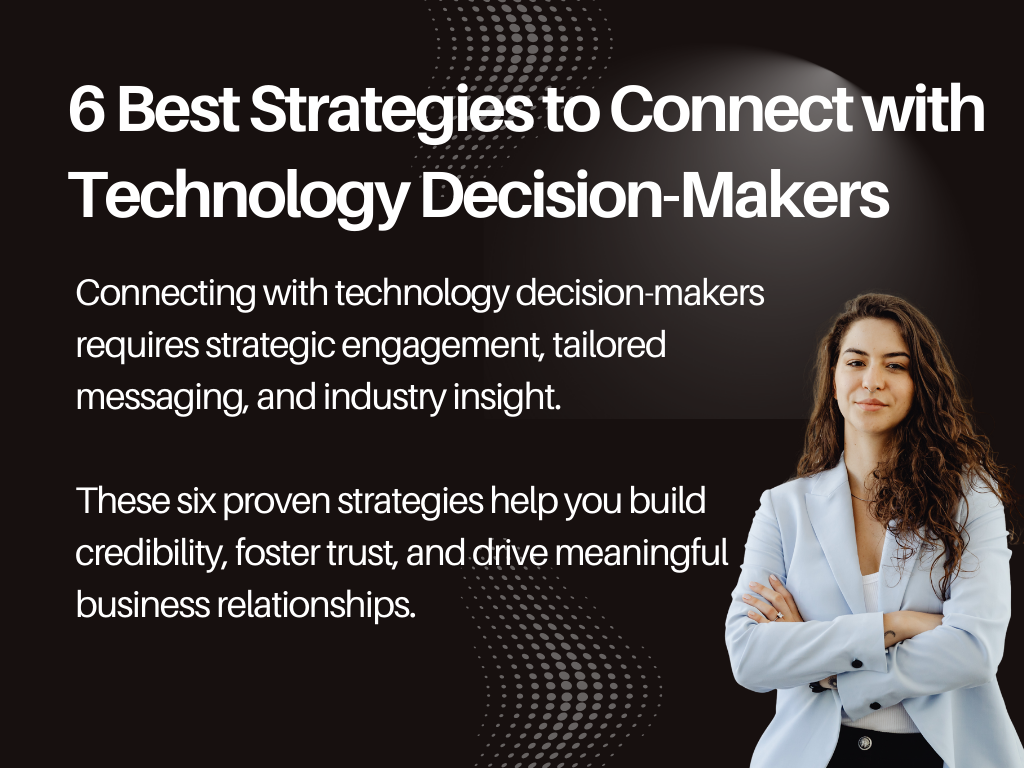- +1 (669)-293-6007
- reach@techdatapark.com
- 3080 Olcott St D205, Santa Clara, CA 95054, United States

Are you trying to connect with technology decision-makers? It’s not as difficult as you think! In 2025, technology decision-makers plays a key role in driving efficiency and innovation. They are responsible for selecting the right tools, platforms, and solutions that align with business goals. With rapid advancement in technology, leaders’ choices can shape a company’s competitive edge.
For B2B marketers, reaching technology decision-makers means connecting directly with the influencers driving transformation. In today’s tech-driven marketplace, understanding their needs, pain points, and priorities is essential for quality lead generation.
In this ultimate guide, we will cover everything you need to know about finding, connecting with, and growing relationships with technology decision-makers.
Technology decision-makers are professionals within an organization who have the authority to evaluate, select and approve technology solutions. They are often senior-level executives including:
These individuals assess business needs, compare vendors, allocate budgets, and ensure that chosen technologies align with long-term goals. Beyond technical expertise, they also understand operational requirements, risk management and ROI.
In addition to that, IT decision-makers bridge the gap between business strategy and technical execution. Thus making decisions in shaping an organization’s technological future.
Industries Where They Play a Key Role:
Targeting verified technology decision-makers ensures that your marketing efforts reach the individuals with budget authority and influence over technology purchases. Engaging with these contacts can:
Many IT organizations and SaaS companies use technology users contacts to connect with the decision-makers and generate leads. With the help of trusted data providers, they gain access to verified contacts and boost business ROI with ease.
Technology decision-makers are the architects of a company’s tech strategy. In the B2B world, their influence extends far beyond simply approving purchases. They shape how technology drives business growth.
First, they identify challenges and opportunities within the organization, determining where technology can deliver the most impact. This might involve improving workflows, enhancing customer experience, or boosting operational efficiency.
Next, they evaluate and compare vendors, looking closely at product features, scalability, integration capabilities, and security. They’re not just seeking the latest tools. They want solutions that align perfectly with business goals.
Finally, they negotiate, approve, and oversee implementation, ensuring that investments generate measurable ROI. By balancing technical expertise with strategic vision, technology decision makers act as the crucial link between business objectives and technological innovation.
Technology decision-makers are busy, selective, and cautious. They get flooded with pitches, trust peer recommendations over cold outreach. Moreover, they expect data-backed proof before making a move. Many decisions also involve multiple stakeholders, adding extra layers of approval.
How to overcome it: Be concise, personalize your approach, share credible case studies, use clear ROI metrics, and engage all key players in the decision chain.
If "yes", you are still missing out an opportunity to connect with your ideal prospects. Click below to see how to increase ABM results!
Maximize ABM ResultsReaching technology decision-makers requires a smart mix of research, personalization, and the right tools. These six proven strategies will help you grab their attention, build trust, and start meaningful business conversations.

Before reaching out, clearly identify who you’re targeting (CIOs, CTOs, IT Directors, or Heads of Innovation). Understand their roles, priorities, and pain points by researching company structures, industry trends, and recent technology investments. The more you know about them, the more relevant and appealing your outreach will be.
Generic pitches get ignored. Tailor your emails, LinkedIn messages, and calls to address each decision maker’s specific needs. Reference their company initiatives, recent projects, or industry developments to show you’ve done your homework. Personalization signals that you value their time and have a genuine interest in solving their challenges.
LinkedIn remains a top platform for reaching technology leaders. Follow them, engage with their content, and join relevant industry groups. Thoughtful comments, insightful posts, and personalized connection requests help you warm up the relationship before making a direct pitch. Professional networking builds familiarity and trust over time.
Decision-makers respond to expertise backed by evidence. Share high-value content such as whitepapers, case studies, industry reports, and webinars that address their pain points. Providing actionable insights positions you as a trusted resource rather than just another salesperson, increasing your chances of engagement.
Relying on a single outreach method limits your success. Combine email marketing, LinkedIn engagement, industry event participation, and even warm referrals to reach decision-makers from different angles. Consistent, multi-channel touchpoints keep you on their radar without overwhelming them.
Using a verified technographic database allows you to identify companies based on their current technology stack and directly access the contact details of key decision-makers. This ensures your outreach is highly targeted, relevant, and more likely to convert. Data-driven targeting saves time and boosts your ROI in connecting with the right people.
At TechDataPark, they offer quality technology users email list that consists of 10M+ verified tech user contacts. These lists are verified and updated every 45 days to maintain a high level of accuracy and compliance with global data privacy regulations. They carry out 7-tier verification processes to gain active and 100% opt-in contacts.
Accurate, up-to-date contact details ensure:
Fuel targeted campaigns with accurate B2B data on technology users across industries.
Get Customized ListEven with the right strategies in place, small missteps can derail your outreach to technology decision-makers. These professionals are busy, highly selective, and expect value from every interaction. Avoid these common mistakes to keep your campaigns effective and impactful:
Decision-makers can instantly spot a mass email or scripted pitch. Sending the same template to every prospect shows a lack of effort and relevance. Instead, tailor each message to address the recipient’s specific role, company initiatives, and pain points. Personalization demonstrates that you’ve done your research and genuinely understand their needs.
Not every senior title is a decision maker for technology purchases. Targeting irrelevant contacts wastes time and budget. Use technographic data, company org charts, and LinkedIn insights to ensure you’re speaking to the individuals who influence or approve technology investments.
Tech leaders aren’t impressed by jargon-filled feature lists. They care about solutions. Overemphasizing technical specs without explaining the business impact is a quick way to lose interest. Focus on ROI, efficiency gains, risk reduction, and competitive advantage.
In most organizations, purchasing decisions involve several influencers, from finance to operations. Focusing solely on one person risks delays or rejections. Engage multiple stakeholders early to build alignment and consensus.
Outdated or inaccurate contact information not only wastes effort but can also damage your sender reputation. Regularly clean, verify, and enrich your database using trusted B2B data or technographic providers to keep your outreach effective. In addition to that, many businesses opt to buy technology users list to connect with the right prospects.
Reaching Technology Decision-Makers in 2025 is no longer about who can send the most emails or make the most calls. It’s about who can deliver the right message to the right person at exactly the right time. These decision-makers are intelligent, data-driven, and cautious about committing to new solutions. If you want their attention, you must demonstrate genuine understanding of their pain points, back your claims with solid proof, and present a clear ROI path.
By leveraging technographic data and an accurate Technology Users Email List, you can skip the guesswork and target organizations already aligned with your ideal customer profile. Pair that precision targeting with personalized outreach, account-based marketing, and value-first communication, and you transform cold contacts into engaged prospects.

Mark Felix brings a unique blend of tech expertise and marketing know-how to his role at TechDataPark. With a background in data analytics and technology marketing, Mark is skilled at helping businesses leverage targeted tech users lists to expand their reach and drive conversions. His data-driven approach enables him to craft compelling marketing strategies that resonate with tech audiences. Outside of work, Mark enjoys staying on top of cutting-edge technology trends and exploring how data continues to transform the marketing landscape.

Why Marketing Agencies Rely on Tech Email Lists for Campaign Success Table of Contents Imagine launching a marketing campaign that hits the inbox of every single decision-maker, developer, or IT

Who Buys Technology Users Lists? In today’s competitive B2B landscape, precise targeting has become a fundamental aspect of successful marketing and sales strategies. This is where Technology Users Lists come

How to Target IT Decision-Makers With Email Campaigns IT decision-makers such as CIOs, CTOs, IT managers, and procurement heads are among the most valuable yet challenging audiences to reach through